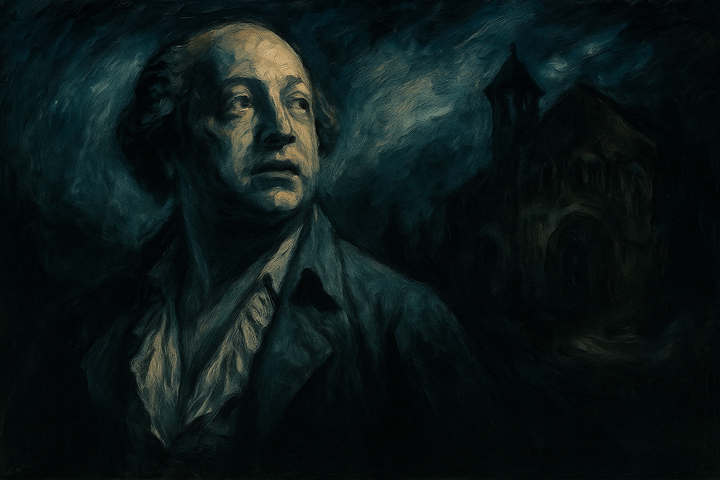The Haunting of Medveđa: Unearthing the Truth Behind the Arnold Paole Vampire Panic

In the annals of the uncanny, few cases are as chillingly detailed or influential as that of Arnold Paole. His name, recorded as "Arnont Paule" in original German documents, likely represented the Serbian Арнаут Павле (Arnaut Pavle). This naming is significant: "Pavle" is a common Serbian form of Paul, but "Arnaut" (Арнаут) was a Turkish term often used to denote Albanians or those from Albanian-inhabited lands. Thus, Arnold Paole may have been known as "Pavle the Albanian."
This potential identity casts his personal history in a new light. Paole, a Serbian hajduk (a type of irregular soldier or rebel), frequently spoke of being tormented by a vampire in a place called "Gossowa"—widely believed to be Kosovo, a region with deep historical Albanian connections. If Paole was identified as "Arnaut," his prior vampire encounter in Kosovo gains a resonant cultural and geographical context. He claimed to have cured himself through grim folk remedies: ingesting earth from that vampire's grave and anointing himself with its blood.
Around 1726, this man, possibly marked by his perceived ethnicity and carrying the trauma of a previous vampiric assault, died in his adopted village of Medveđa (located on the West Morava river near Trstenik, distinct from the modern town of Medveđa in southern Serbia).
His accidental death triggered a horrifying vampire panic. The subsequent investigation by Austrian military officials and physicians, meticulously documented, propelled the belief in vampires across Enlightenment Europe and helped shape the terrifying archetype for generations.
A Frontier Forged in Conflict and Superstition
The stage for these events was the volatile Austro-Ottoman borderlands. After the 1718 Treaty of Passarowitz, the Habsburg Monarchy annexed parts of Serbia, including Medveđa. These were sparsely populated, war-scarred territories. The Austrians sought to secure the region by recruiting locals, like Paole, into militias. It was in these frontier communities, steeped in local superstitions and the anxieties of recent conflict, that some of the earliest and most detailed vampire scares were recorded.
During this Austrian interlude, these frontier districts were governed by direct military rule from Vienna. The region was in a dire state, a consequence of preceding brutal Austrian-Ottoman conflicts. The population was sparse and often nomadic, agriculture was minimal, and the economy leaned heavily on cattle-breeding. The Austrian authorities were keen to stabilize and develop these territories, encouraging settlement, particularly by German-speaking Serbs. A key strategy involved recruiting local Serbs, many of whom were former hajduks (irregular militiamen or freedom fighters, often with a romanticized image akin to bandits or rebels against Ottoman rule), into militias. These men were tasked with peacetime border protection and wartime military service in exchange for inalienable land plots. It was within these recently settled, often volatile, and deeply superstitious communities that some of the earliest and most extensively documented vampire scares, including that of Arnold Paole, emerged.
The First Shadow: Arnold Paole's Death and the Unseen Tormentor
The story, as pieced together from Flückinger's later report which recounted the locals' testimony, begins with Arnold Paole himself. A hajduk by profession, Paole was a relative newcomer to Medveđa, having moved from a Turkish-controlled area of Serbia. He was, by his own admission, no stranger to the supernatural. He frequently spoke of a terrifying experience in a place he called "Gossowa" (speculated to be Kosovo), where he claimed to have been tormented by a vampire. Paole believed he had cured himself of this affliction through traditional folk rituals: ingesting soil from the vampire's grave and anointing himself with its blood.
Around 1725, Paole met a mundane, albeit tragic, end. He died from injuries sustained in a fall from a haywagon, specifically a broken neck. However, the ordinariness of his death soon gave way to extraordinary terror. Within a mere 20 to 30 days following his burial, four villagers began to complain of being "plagued" by the deceased Paole. All four individuals died shortly thereafter, sowing seeds of dread throughout Medveđa.
Fear escalated quickly. Approximately ten days after these initial deaths, and a full forty days after Paole's own demise, the villagers, under the guidance of their hadnack (a local military or administrative leader who reportedly had prior experience with such gruesome affairs), decided to take action. They exhumed Arnold Paole's body.
The sight that confronted them, as later documented, became a chilling catalogue of supposed vampiric traits. Paole's corpse was described as "undecomposed." More disturbingly, fresh blood was reportedly observed at his eyes, nose, mouth, and ears. His veins were said to be engorged with "fluid-blood." According to the account, "the shirt, the covering, and the coffin were completely bloody." It was also claimed that "the old nails on his hands and feet, along with the skin, had fallen off, and that new ones had grown." Furthermore, his body appeared "red," and his hair, nails, and beard seemed to have undergone post-mortem growth.
Convinced beyond doubt that Paole was a vampire, the villagers performed the customary, brutal ritual. They drove a stake through his heart, to which the corpse allegedly reacted with a "frightful shriek as if he were alive, groaning and bleeding." Following this, they decapitated him and burned the entire body. To ensure the contagion was contained, the four individuals believed to be Paole's initial victims were also disinterred and subjected to the same grisly procedures, lest they too rise as vampires. For a time, it seemed the horror had been purged.
The Calm Before the Storm: A Deceptive Interlude and a Vicious Return
For roughly five years, an uneasy peace settled over Medveđa. But in the harsh winter of 1731, the specter of death returned with a vengeance. A new epidemic swept through the village, claiming more than ten lives within a few weeks. Some victims succumbed rapidly, within two or three days of falling ill, displaying no prior signs of sickness. Others suffered a more prolonged decline. The exact number and ages of the deceased vary slightly between the primary sources – the reports of Glaser and Flückinger.
Dr. Glaser's report, dated to reflect observations by December 12, 1731, states that thirteen people had perished over six weeks. He listed victims including: Miliza (Serbian: Milica), a 50-year-old woman; Milloi (Miloje), a 14-year-old boy; Joachim, a 15-year-old boy; Peter (Petar), a mere 15-day-old infant; Stanno (Stana), a 20-year-old woman, and her newborn child (who Glaser noted was buried "behind a fence, where the mother had lived" due to not having lived long enough for baptism); Wutschiza (Vučica), a nine-year-old boy; Milosova (Milosava), the 30-year-old wife of a hajduk; Radi (Rade), a 24-year-old man; and Ruschiza (Ružica), a 40-year-old woman. Those afflicted complained of sharp, stabbing pains in their sides and chest, persistent fever, and convulsive jerking of the limbs.
According to Glaser, the villagers quickly identified Milica and Stana as the instigators of this new wave of vampirism. Milica had arrived in Medveđa from Ottoman-controlled territory six years prior. While generally considered a good neighbor who had never, to their knowledge, engaged in "something diabolic," she had once casually mentioned eating two sheep that had been killed by vampires while still living in Ottoman lands. Stana, on the other hand, reportedly confessed to having smeared herself with vampire blood in Ottoman territory as a protective ward against vampires, which were said to be rampant there. Local belief held that both these actions doomed the women to become vampires after their deaths.
Flückinger's later report, detailing events up to January 7, 1732, stated that seventeen people had died over a three-month period (the last two deaths seemingly occurring after Glaser's visit). His list included: Miliza (Milica), noted as a 69-year-old woman who died after a three-month illness; an unnamed 8-year-old child; Milloe (Miloje), a 16-year-old boy who died after a three-day illness; Stana, a 20-year-old woman who died in childbirth after a three-day illness (Flückinger notes she reportedly said she had smeared herself with vampire blood), along with her stillborn child (which Flückinger disturbingly observed was "half-eaten by the dogs due to a slovenly burial"); an unnamed 10-year-old girl; Joachim, a 17-year-old who died after a three-day illness; the hadnack's unnamed wife; Ruscha (Ruža, a variant of Ružica), a woman who died after a ten-day illness; Staniko (Stanjko), a 60-year-old man; another Miloe (Miloje), the second victim bearing that name, a 25-year-old man; Ruža's 18-day-old child; Rhade (Rade), a 21-year-old servant of the local hajduk corporal, who died after a three-month illness; the local standard-bearer's (barjaktar's) unnamed wife (apparently the Milosava from Glaser's report) along with her child; the hadnack's eight-week-old child; and Stanoicka (Stanojka), a 20-year-old wife of a hajduk, who died after a three-day illness.
A particularly chilling account concerned Stanojka. Her father-in-law, Joviza (Jovica), testified that Stanojka had gone to bed in perfect health fifteen days prior but had awoken at midnight, terrified and screaming that she had been throttled by the recently deceased Miloje (the son of Heyducq Millo, dead nine weeks, according to Calmet's later analysis). From that moment, Stanojka fell into a languid state and died three days later. This accusation immediately identified Miloje as a vampire.
Flückinger reported that the villagers attributed this new epidemic to the fact that Milica, the first to die in this second wave, had consumed the meat of sheep killed by the "previous vampires"—Arnold Paole and his victims from five years earlier. He also noted, almost in passing, the claims that Stana had admitted, before her death, to smearing herself with vampire blood for protection, an act which, along with her child, would condemn her to vampirism. Augustin Calmet, in his analysis, added another layer: "They discovered at last, after much search, that the defunct Arnold Paul had killed not only the four persons of whom we have spoken, but also several oxen, of which the new vampires had eaten, and amongst others the son of Millo." This suggested a chain of contamination through ingested animal flesh.
The Imperial Gaze: Austrian Authorities Investigate
The escalating death toll and the palpable terror of the villagers eventually reached Oberstleutnant Schnezzer, the Austrian military commander responsible for the area's administration. Schnezzer, fearing a potential outbreak of pestilence, dispatched Imperial Contagions-Medicus Glaser from the nearby town of Paraćin to investigate.
On December 12, 1731, Glaser arrived in Medveđa. He meticulously examined the afflicted villagers and their homes but found no clinical signs of a recognized contagious malady. He initially attributed the deaths to the widespread malnutrition in the region and the potentially debilitating effects of the severe Eastern Orthodox fasting practices. The villagers, however, were unswayed. They remained convinced that vampires were the cause of their suffering. Some households had resorted to gathering together at night, with individuals taking turns sleeping while others kept a fearful watch. They vehemently insisted that the deaths would not cease unless the authorities sanctioned the "execution" of the suspected vampires, even threatening to abandon their village en masse to save their lives if their pleas were ignored.
Faced with this unwavering conviction and the potential for social breakdown, Glaser reluctantly consented to the exhumation of some of the recently deceased. What he witnessed evidently surprised him. He reported that most of the exhumed bodies were indeed not decomposed, many appeared swollen, and several had blood in their mouths. In contrast, a few others who had died more recently (specifically Vučica, Milosava, and Rade) were significantly more decomposed. In his official report to the Jagodina commandant's office, Glaser outlined his findings and, significantly, recommended that the authorities appease the terrified populace by fulfilling their demand to "execute" the suspected vampires. Schnezzer forwarded Glaser's report up the chain of command to the Supreme Command in Belgrade (then under Austrian control). The vice-commandant, Botta Adorno, responded by dispatching a second, more formal commission to Medveđa.
This new commission, which arrived in January 1732, was a more formidable investigative team. It included military surgeon Johann Flückinger, Lieutenant Colonel Büttner, J.H. von Lindenfels, and two other military surgeons, Siegele and Johann Friedrich Baumgarten. On January 7, accompanied by village elders and local Gypsies (who were often tasked with the grim work of exhumation and dispatch), the commission began opening the graves of those who had died in the second outbreak.
Their findings largely corroborated Glaser's earlier observations but were documented with far greater anatomical detail in Flückinger's subsequent report. The commission established that out of seventeen bodies examined (the total number of deceased varies slightly across reports), five—the hadnack's wife and child, Rade, and the standard-bearer's wife and child—were found in an advanced state of decomposition.
However, the remaining twelve corpses were described as "quite complete and undecayed" and exhibited the precise characteristics commonly associated with vampirism in the local belief system. Their chests, and in some cases other organs, were reportedly filled with fresh, uncoagulated blood. Their viscera (internal organs) were assessed as being in "good condition." The corpses generally appeared plump, and their skin retained a "red and vivid" color, rather than the expected pallor of death. In several instances, it was meticulously noted that "the skin on ... hands and feet, along with the old nails, fell away on their own, but on the other hand completely new nails were evident, along with a fresh and vivid skin."
The case of Milica (the 69-year-old woman) was particularly striking to the hajduks assisting with the dissection. They recalled her as having been "lean and dried-up" throughout her life, and were astonished to find her body plump in the grave. The surgeons collectively described these bodies as being in a "vampiric condition" (Vampyrenstand).
Following the thorough examination, the Gypsies, under the commission's observation, decapitated the supposed vampires, burned both their heads and bodies, and cast the ashes into the West Morava river. The bodies that were found to be decomposed were simply reinterred. Flückinger's comprehensive report, formally dated January 26, 1732, from Belgrade, bore the signatures of all five participating Austrian officials.
The story of Arnold Paole and the Medveđa vampires quickly spread beyond the Serbian frontier. On February 13, 1732, Dr. Johann Friedrich Glaser, the father of the initial investigator and a correspondent for the Nuremberg journal Commercium Litterarium, sent the editors a letter detailing the entire affair as recounted to him by his son (who had written to him on January 18). This letter, alongside both official reports (especially Flückinger's more detailed account), was reprinted in numerous articles and scholarly treatises, igniting widespread interest and debate across Europe.
Calmet noted the thoroughness of the official response: "All the information and executions we have just mentioned were made judicial, in proper form, and attested by several officers who were garrisoned in the country, by the chief surgeons of the regiments, and by the principal inhabitants of the place. The verbal process of it was sent towards the end of last January to the Imperial Counsel of War at Vienna, which had established a military commission to examine into the truth of all these circumstances."
Peeling Back the Shroud: Modern Explanations for Ancient Terrors
While the 18th-century reports from Medveđa lent an air of official validation to vampirism, modern science provides far more prosaic, though no less fascinating, explanations for the "vampiric condition" observed by Glaser and Flückinger. The seemingly supernatural state of the corpses can be attributed to natural decomposition processes occurring under specific environmental conditions:
- Delayed Decomposition: Burial in cold, damp, or anaerobic (oxygen-poor) soil can significantly inhibit the natural decay process, leading to bodies appearing remarkably preserved for extended periods.
- Bloating and "Plumpness": As internal organs decompose, bacteria produce gases (such as methane, hydrogen sulfide, and carbon dioxide). These gases accumulate within the body cavities, causing the torso and limbs to swell, giving the corpse a "plump" or "well-fed" appearance – a stark contrast if the individual was thin in life, as noted with Milica.
- "Fresh Blood": The pressure exerted by these internal gases can force decomposition fluids, often stained dark reddish-brown by degraded blood (hemolyzed blood), out of natural orifices like the mouth, nose, and ears. This dark, viscous fluid could easily be mistaken for fresh, liquid blood by untrained or terrified observers.
- Skin and Nail "Growth": The illusion of post-mortem hair and nail growth is a well-understood phenomenon. As the body dehydrates, the skin retracts, particularly around the nail beds and hair follicles. This exposes more of the nail and hair shaft, creating the appearance of growth. Similarly, the outer layers of skin (epidermis) can loosen and slough off ("skin slip"), sometimes revealing newer-looking skin underneath or causing old nails to detach, which might be misinterpreted as new nail growth.
- Sounds from the Corpse: The "frightful shriek" or groans reportedly emitted when Paole's body was staked can be explained by the forceful expulsion of trapped putrefaction gases through the trachea (windpipe) as the chest cavity is pierced or manipulated.
The local beliefs regarding the transmission of vampirism—eating sheep killed by vampires, or self-anointing with vampire blood—further underscore the potent interplay of cultural folklore and psychological contagion. Paole's own tales of his encounters in "Gossowa" had already primed the community for such interpretations. Subsequent unexplained deaths, especially during harsh winters when illness was common and food scarce, were readily filtered through this terrifying, pre-existing framework.
The Enduring Echo of Arnold Paole
The case of Arnold Paole, alongside that of Petar Blagojević, stands as a pivotal moment in the Western European understanding and conceptualization of the vampire. The seemingly objective, detailed, and official documentation by Austrian military personnel, particularly surgeons, lent a chilling veneer of empirical credibility to phenomena that resided firmly in the realm of folklore. These reports, disseminated widely, provided a rich, if misinterpreted, corpus of "evidence" that captivated an Enlightenment-era audience—an audience that was, despite its burgeoning rationalism, still deeply fascinated by the macabre, the exotic, and the unexplained.
The "vampires" of Medveđa were almost certainly not supernatural entities but rather the unfortunate subjects of fear, misunderstanding, and the limitations of 18th-century medical and forensic knowledge. Yet, their story, meticulously recorded and widely publicized, played a crucial role in solidifying the vampire archetype in the European consciousness: the undecomposed revenant, bloated with the blood of its victims, its nails and hair still growing, a malevolent presence rising from the grave to prey upon the living.
Though the soil of Medveđa has long since settled, and Arnold Paole presumably rests in peace, his name and the terrifying events associated with his death and alleged undeath continue to resonate. The case remains a potent reminder of how community fear, ancient beliefs, and the inexplicable nature of death can converge to create enduring myths. It also highlights how even official attempts to understand and control such outbreaks can inadvertently contribute to the very legends they seek to investigate, ensuring that the shadow of the vampire would stretch far beyond the Serbian frontier and deep into the heart of Western imagination.




